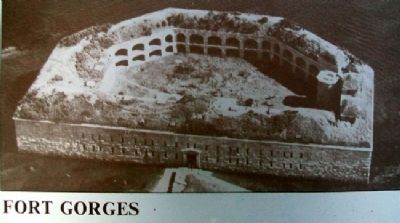Fort Gorges from East Promenade Park, Portland, ME
Built on Hog Island Ledge, Fort Gorges was named after Sir Ferdinando Gorges, colonial proprietor of the Province of Maine. The fort's site allowed it to provide supplemental fire to both Fort Preble and Fort Scammel. Its location at the head of the harbor would also serve as a deterrent to vessels entering through the channels on either side of Peaks Island. Attackers coming around behind Great Diamond Island could be repelled by cannon on the top rear of the fort.
Work on Fort Gorges had began in 1858, and the pace of construction was increased with the outbreak of the Civil War. It was designed as a truncated octagon with a long sixth side at the rear, similar to Fort Sumter in Charleston, South Carolina. Granite walls were four feet thick.
The double-tiered arched gun galleries were to hold 28 cannon on each level. Rifle slits were provided along the rear wall, and the top tier was designed for 39 gun emplacements. The gun ports in the walls had iron shutters that opened and closed automatically in conjunction with the firing of the track-mounted cannon.
Construction was nearly complete by 1865, but no guns had been mounted at the end of the war. The ineffectiveness of cannon against steel-hulled ships, as evidenced in the battle between the Monitor and the Merrimack, helped render this fort obsolete.
| |||||
| Fort Gorges Photo on Marker | |||||
In this century, a storehouse was built on the parade ground. Submarine mines were kept here for use in World Wars I and II.
The fort was last used by the military during World War II when it was used to store submarine mines. It was acquired by the city of Portland in 1960 and placed on the National Register of Historic Places. It is now open to the public as a park, and is accessible only by private boat. Visitors are recommended to carry a flashlight to enter the powder magazines.
Accessing the island involves crossing areas with strong tidal currents and should thus be attempted only under the right conditions, by people with sufficient experience, using a proper boat, i.e. don't try it with a canoe.


No comments:
Post a Comment